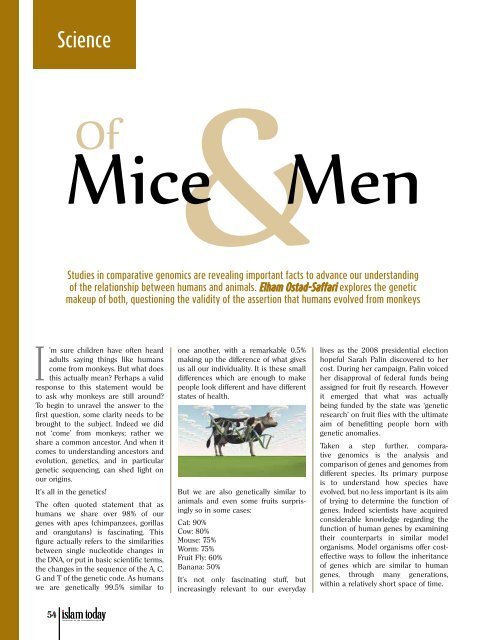You also want an ePaper? Increase the reach of your titles
YUMPU automatically turns print PDFs into web optimized ePapers that Google loves.
Science&Mice MenStudies in comparative genomics are revealing important facts to advance our understandingof the relationship between humans and animals. Elham Ostad-Saffari explores the geneticmakeup of both, questioning the validity of the assertion that humans evolved from monkeysOfI’m sure children have often heardadults saying things like humanscome from monkeys. But what doesthis actually mean? Perhaps a validresponse to this statement would beto ask why monkeys are still around?To begin to unravel the answer to thefirst question, some clarity needs to bebrought to the subject. Indeed we didnot ‘come’ from monkeys; rather weshare a common ancestor. And when itcomes to understanding ancestors andevolution, genetics, and in particulargenetic sequencing, can shed light onour origins.It’s all in the genetics!The often quoted statement that ashumans we share over 98% of ourgenes with apes (chimpanzees, gorillasand orangutans) is fascinating. Thisfigure actually refers to the similaritiesbetween single nucleotide changes inthe DNA, or put in basic scientific terms,the changes in the sequence of the A, C,G and T of the genetic code. As humanswe are genetically 99.5% similar toone another, with a remarkable 0.5%making up the difference of what givesus all our individuality. It is these smalldifferences which are enough to makepeople look different and have differentstates of health.But we are also genetically similar toanimals and even some fruits surprisinglyso in some cases:Cat: 90%Cow: 80%Mouse: 75%Worm: 75%Fruit Fly: 60%Banana: 50%It’s not only fascinating stuff, butincreasingly relevant to our everydaylives as the 2008 presidential electionhopeful Sarah Palin discovered to hercost. During her campaign, Palin voicedher disapproval of federal funds beingassigned for fruit fly research. Howeverit emerged that what was actuallybeing funded by the state was ‘geneticresearch’ on fruit flies with the ultimateaim of benefitting people born withgenetic anomalies.Taken a step further, comparativegenomics is the analysis andcomparison of genes and genomes fromdifferent species. Its primary purposeis to understand how species haveevolved, but no less important is its aimof trying to determine the function ofgenes. Indeed scientists have acquiredconsiderable knowledge regarding thefunction of human genes by examiningtheir counterparts in similar modelorganisms. Model organisms offer costeffectiveways to follow the inheritanceof genes which are similar to humangenes, through many generations,within a relatively short space of time.By comparing the genes from differentspecies, particularly genes which havebeen preserved in multiple species overmillions of years, – including specieswith which we share strong geneticsimilarities – scientists hope to findsimilarities as well as differences whichmay contribute to our understandingof how human genesfunction. This approach is alsoused by scientists to develop newstrategies for the treatment andprevention of human diseases.One must also not forget theimportance of studying the genesof bacteria, viruses and fungi.Through such research, scientistshope to find ways of preventing ortreating infections, as well as learnhow microbes in and on the bodyaffect human health in beneficialways. Our knowledge of good orfriendly bacteria, Bifidobacteriumlactis, sometimes also referredto as pro-biotic (the type foundin some yogurts) is testament tosuch research in bacteria.Scientists hope to analyse moreclosely these basic buildingblocks of life, the nucleotidesand their sequences, betweenspecies. What scientists look forare the nucleotides which whenchanged from species to specieshave a ‘neutral’ effect, causingno significant changes. Howeverthe jackpot lies in the analysisof a relatively small percentageof genes, which can cause substantialdifferences if alterations are introduced.Of particular interest and fascinationare the changes which can be put intothe context of known inherited humandiseases. Indeed a single nucleotidechange can cause the inheritance ofcystic fibrosis, breast cancer or sicklecell disease. Single nucleotide changeshave also been linked to hereditarydifferences in height, brain development,facial structure and pigmentation.Due to a single change, handscan develop structures that are similarto toes instead of fingers and mostbizarrely, a mouse’s tail can disappearaltogether!While new foundations are being laidfor the diagnosis and treatment ofhuman diseases, this progress is alsomet with important ethical and social<strong>issue</strong>s. These include confidentiality,as well as the stigmatising of potential‘new’ genetic information beingresearched and published. While theseethical implications are not uniqueto genetics, they introduce the newlanguage of ‘probability’ and ‘susceptibility’to medical care. Indeed the wealthof information which can be gainedfrom such analyses is of great interestto third parties, including families,governments, insurance companies,law enforcement agencies as well asscientific researchers. Thus while suchresearch is of utmost importance, theethical, legal and social implicationsmust also be carefully considered.As complex as we are, it is worthremembering that gene reading orsequencing does have different levels,and while some reading is importantto see every base pair change, otherreadings have coarser granularity. Forexample, while we may share 75% similaritywith a nematode worm or mouse,the remaining 25% dissimilarity meansthat all three species actually havesignificantly different features and lookphysically unique. Furthermorethis complexity is increased whenone considers that these uniquefeatures are often controlled bymore than one gene or even asingle nucleotide change.Another fascinating example isthe remarkable resemblance infunction and structural similarityseen in the eyes of octopuses andhumans. Despite their similar eyes,there is currently no evolutionaryrelationship between these twoseemingly opposed species.There are undeniable similaritiesbetween humans and the manydifferent species of animals withinthe world. Apes resemble humansin their anatomical structure,horses in their intellect, parrotsin their speech, bees in theirart, ants in their sociability andpenguins in the compassion theyshare for their young. But nonehas all these features at once.All these bring to mind the verseof the Qur’an which implies thatthe origin of all species is one:‘God has created every animalout of water; some of them walkon their belly, while others walk on twolegs and still others walk on four. Godcreates anything He wishes; God is Ableto do everything’. (24:45) •Elham Ostad-Saffarihas a PhD in MedicalGenetics from ImperialCollege London. She iscurrently working in thepharmaceutical industry.5455


